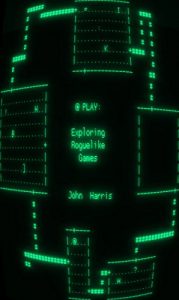For over nine years the column @Play has covered the genre of roguelike computer games, on indie blog GameSetWatch and beyond, discovering and exploring its many fascinating corners. Now for the first time the best articles from its run, along with a collection of new pieces, are brought together in one volume.
Within are articles on:
* Playing tips and strategy for newcomers to the genre
* Core roguelikes Rogue, Angband, NetHack, Dungeon Crawl Stone Soup, ADOM and Brogue
* The "lost roguelikes" Super Rogue and XRogue, and the early RPG dnd for PLATO systems
* The Japanese console roguelikes Taloon's Mystery Dungeon and Shiren the Wanderer
* Lesser-known but extremely interesting games like Larn, DoomRL, HyperRogue, Incursion and Dungeon Hack
* "Rogue-ish" games that blur the edges of the genre like Strange Adventures in Infinite Space, Spelunky, HyperRogue, ToeJam & Earl, Defense of the Oasis, Out There and Zelda Randomizer
* Interviews with developers Keith Burgun (100 Rogues and Auro) and Rodain Joubert (Desktop Dungeons), and Robin Bandy, maintainer of the long-running devnull public NetHack tournament
* Design issues of interest to developers and enthusiasts
* Much much more
Since 1980, in-the-know computer gamers have been enthralled by the unpredictable, random, and incredibly deep gameplay of Rogue and those games inspired by it, known to fans as "roguelikes." For decades, this venerable genre was off the radar of most players and developers for a variety of reasons: deceptively simple graphics (often just text characters), high difficulty and their demand that a player bring more of his or herself to the game than your typical AAA title asks.
In roguelike games, the game is randomly recreated every time you play. It is scrambled and forces you to discover important information anew with each game. And, if your character dies, you cannot return to a saved game, but must instead start from scratch with a new character for the next game.
Despite a few exceptions (like ToeJam & Earl and Blizzard's Diablo series), these games have been known mostly to a devoted cadre of hardcore fans. But the times are changing! A new breed of roguelike-styled games are becoming popular on Steam and other download stores, and procedural content generation has hit it big even with major game studios looking to decrease development costs.
Yes, the roguelikes have finally hit the big time. This book (at over 700 pages on an ereader) covers many of the most prominent titles, and explains in great detail what makes them interested, ways to get started playing them, the history of the genre, and much more. It includes interviews, playthroughs and hundreds of screenshots. It is a labor of love: if even a fraction of my enthusiasm for these games gets through these pages to you, then I think you will enjoy it a great deal.
Within are articles on:
* Playing tips and strategy for newcomers to the genre
* Core roguelikes Rogue, Angband, NetHack, Dungeon Crawl Stone Soup, ADOM and Brogue
* The "lost roguelikes" Super Rogue and XRogue, and the early RPG dnd for PLATO systems
* The Japanese console roguelikes Taloon's Mystery Dungeon and Shiren the Wanderer
* Lesser-known but extremely interesting games like Larn, DoomRL, HyperRogue, Incursion and Dungeon Hack
* "Rogue-ish" games that blur the edges of the genre like Strange Adventures in Infinite Space, Spelunky, HyperRogue, ToeJam & Earl, Defense of the Oasis, Out There and Zelda Randomizer
* Interviews with developers Keith Burgun (100 Rogues and Auro) and Rodain Joubert (Desktop Dungeons), and Robin Bandy, maintainer of the long-running devnull public NetHack tournament
* Design issues of interest to developers and enthusiasts
* Much much more
Since 1980, in-the-know computer gamers have been enthralled by the unpredictable, random, and incredibly deep gameplay of Rogue and those games inspired by it, known to fans as "roguelikes." For decades, this venerable genre was off the radar of most players and developers for a variety of reasons: deceptively simple graphics (often just text characters), high difficulty and their demand that a player bring more of his or herself to the game than your typical AAA title asks.
In roguelike games, the game is randomly recreated every time you play. It is scrambled and forces you to discover important information anew with each game. And, if your character dies, you cannot return to a saved game, but must instead start from scratch with a new character for the next game.
Despite a few exceptions (like ToeJam & Earl and Blizzard's Diablo series), these games have been known mostly to a devoted cadre of hardcore fans. But the times are changing! A new breed of roguelike-styled games are becoming popular on Steam and other download stores, and procedural content generation has hit it big even with major game studios looking to decrease development costs.
Yes, the roguelikes have finally hit the big time. This book (at over 700 pages on an ereader) covers many of the most prominent titles, and explains in great detail what makes them interested, ways to get started playing them, the history of the genre, and much more. It includes interviews, playthroughs and hundreds of screenshots. It is a labor of love: if even a fraction of my enthusiasm for these games gets through these pages to you, then I think you will enjoy it a great deal.






